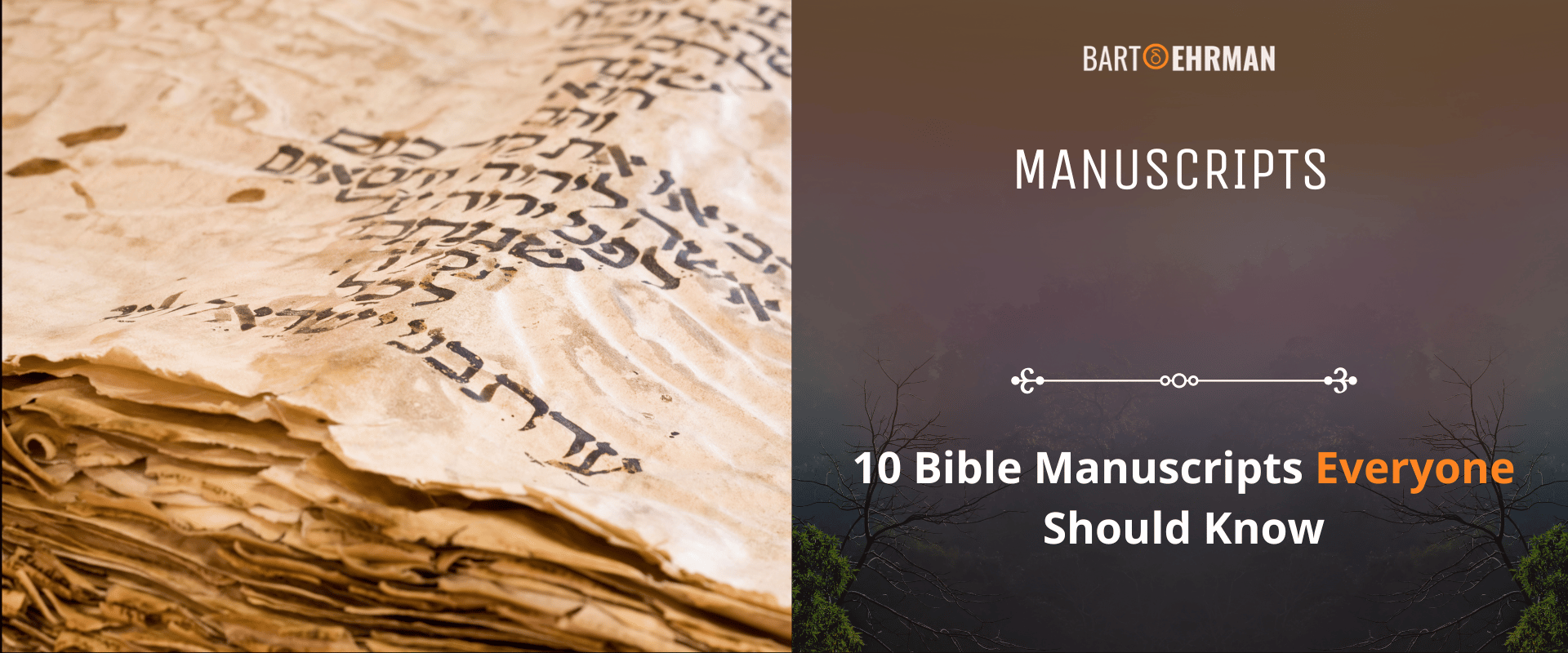10 Bible Manuscripts Everyone Should Know

Written by Marko Marina, Ph.D.
Author | Historian
Author | Historian | BE Contributor
Verified! See our guidelines
Verified! See our editorial guidelines
Date written: February 20th, 2024
Edited by Laura Robinson, Ph.D.
Disclaimer: The views and opinions expressed in this article belong to the author and do not necessarily match my own. - Dr. Bart D. Ehrman
In 2015, I had the privilege of visiting the John Rylands Library in Manchester, a moment that remains etched in my memory for its profound impact. There, encased in protective glass, was a small fragment of papyrus that holds a monumental place in biblical scholarship.
Known among scholars as P52, this papyrus fragment is revered as the oldest known piece of the New Testament Gospels. Standing before P52, I was struck by the tangible connection to the ancient world it represented—a direct link to the early days of Christianity and the textual tradition that has shaped it.
This experience underscored the significance of Bible manuscripts, not just as relics of the past, but as crucial tools in the ongoing quest to understand the historical and textual evolution of one of the world's most influential texts.
These manuscripts, spanning from tiny papyrus fragments to grand, illuminated codices, form the foundation of biblical scholarship. They offer us invaluable insights into the practices of ancient scribes, the complexities of textual transmission, and the relentless efforts of countless individuals dedicated to preserving these sacred texts across millennia.
As we delve into the fascinating world of biblical scrolls, our journey is guided by an objective, scholarly perspective. We seek not to affirm theological doctrines, but to explore the historical, cultural, and textual nuances that these ancient documents reveal.

Bible Manuscripts: The Art of Copying Scripture
We don't have any of the original Biblical texts. It's important, therefore, to briefly consider the technology of writing and copying manuscripts if we are to appreciate the extent and the importance of the Bible manuscripts.
Before the advent of the printing press in the 15th century, the creation and dissemination of biblical texts were solely the domain of human effort—meticulously transcribed by hand. This era of manuscript production, deeply rooted in antiquity, saw the technology of writing evolve in a manner that, while becoming somewhat more accessible over time, never fully shed its intrinsic aura of authority.
Originating in the royal courts of the ancient Near East, including those of Israel, a distinct scribal culture emerged. This culture derived its prestige not only from the sheer rarity and expense of writing materials but also from the significant importance placed on the act of writing itself.
The process of producing and copying manuscripts was both laborious and fraught with challenges, perpetuating a tradition that was as expensive as it was error-prone. Despite these difficulties, or perhaps because of them, the scribal profession maintained a revered status throughout the ancient and medieval worlds.
Scribes were the guardians of knowledge, playing a critical role in the preservation, and transmission of biblical texts. Their work ensured that these sacred writings were handed down through generations, allowing us to study and appreciate these historical documents today.
Within the Biblical world, the role of scribes extended beyond the physical act of writing. They were integral to the education and dissemination of theological knowledge, often serving as interpreters of the law and the prophets within their communities.
Moreover, the scribal work facilitated the continuity of religious and cultural traditions, bridging the gap between generations and geographic locations.
By preserving the Bible manuscripts, scribes played an essential role in shaping the religious landscape of both Judaism and Christianity. This enduring legacy of the scribes underscores the vital link they provided in the chain of transmission that brings these ancient texts into the hands of scholars today.
However, their work wasn't without its challenges, including mistakes and deliberate changes. If you're curious about how scribes might have altered the Bible and the reasons behind such modifications, consider joining Dr. Bart D. Ehrman's enlightening course, "The Scribal Corruption of Scripture: How The Bible Was Changed And How Readers May Never Know”
Bible Manuscripts: Numbers, Dates, and Importance
How many Bible manuscripts are there? This pivotal question invites us into the expansive and intricate world of biblical manuscript tradition. As noted by Dr. Bart D. Ehrman, with over 5,700 New Testament manuscripts in existence, scholars have a vast repository of Greek texts to compare and study.
However, it's important to note that the Bible manuscripts extend beyond Greek. The Old Testament, for instance, was originally composed in Hebrew, with parts in Aramaic, while the New Testament manuscripts are predominantly in Greek.
Over the centuries, these texts have been translated into Latin, Coptic, Syriac, Armenian, and other languages, further expanding the scope of manuscript tradition and scholarly inquiry.
This figure, however, only scratches the surface of the complexity involved in biblical scholarship, particularly when considering the manuscripts' dates and the variances among them.
Ehrman poignantly highlights the challenges faced by scholars: "What is unsettling for those who want to know what the original text looked like is not the number of New Testament manuscripts but their dates and the differences among them."
The earliest remains of these texts are almost invariably fragmentary, primarily written on papyrus. It wasn't until the 4th century C.E. that the first real codices, resembling what we today would recognize as a "book," appeared.
This gap between the original compositions and their surviving copies—such as our earliest complete copy of Paul’s epistle to Galatians dating around 200 C.E., some 150 years after the original—underscores the monumental task of piecing together the New Testament's textual history.
Ehrman further elucidates, "It's not simply a matter of scholarly speculation to say that the words of the New Testament were changed in the process of copying. We know they were changed because we can compare all 5,700 copies with one another."
The realization that no two copies (except perhaps the smallest fragments) agree in all their wording brings to light the scribes' role in the transmission process. Their alterations, whether intentional or accidental, contribute to the complex tapestry of textual variants that scholars sift through in their quest to approach the original Biblical text.
But, as Ehrman notes in his bestseller “Misquoting Jesus”, the problem of finding the original text is exacerbated by the fact that once a mistake was made, it could become firmly embedded in the textual tradition, more firmly embedded, in fact, than the original.
Turning our attention to the Old Testament, the discovery of the Dead Sea Scrolls in the mid-20th century revolutionized our understanding of its manuscripts' antiquity and authenticity.
Among these, the Isaiah Scroll stands out as one of the most complete and oldest surviving manuscripts of any Old Testament book, dating back to the 2nd century B.C.E. These Bible scrolls, found in the Qumran Caves near the Dead Sea, include fragments and full texts of almost every book in the Hebrew Bible, written in Hebrew, Aramaic, and Greek.
Their significance cannot be overstated; they provide a window into the textual variations and the state of the biblical text approximately a thousand years earlier than the previously known oldest manuscripts, such as the Aleppo Codex and the Leningrad Codex, which date to the 10th and 11th centuries C.E., respectively.
The Dead Sea Scrolls thus serve as crucial benchmarks for scholars in assessing the nature of the biblical text's transmission over centuries.
By engaging with the scholarly work of experts like Bart D. Ehrman and Bruce Metzger, we gain insight into the fundamental question of biblical manuscript tradition: How close can we get to the original Biblical text?
With this foundational understanding of the languages and complexities inherent in the biblical manuscript tradition, particularly the New Testament originally written in Koine Greek, we now turn our focus to the earliest manuscripts of the Gospel of Matthew.
New Testament Manuscripts: Matthew as the Case Study
The Gospel of Matthew, among the four canonical Gospels, held a place of particular prominence in the early Christian world. As Edouard Massaux notes: “Of all the New Testament Writings, the Gospel of Matthew was the one whose literary influence was the most widespread and the most profound in Christian literature that extended into the last decades of the second century…It created the background for ‘ordinary’ Christianity.”
In the scholarly debate over the dating and authorship of Matthew's Gospel, a consensus emerges that contrasts with early Church tradition. It suggests that this Gospel was penned by an anonymous Christian author, likely residing outside of Palestine, perhaps in a vibrant community like Antioch, several decades after Jesus' death, around 80-90 C.E.
This time frame places its composition significantly later than the events it describes, contributing to the ongoing scholarly dialogue about its historical reliability.
Many of my students come with the initial assumption that we possess complete manuscripts of the Gospel of Matthew dating back to the dawn of the 2nd century. Oh, how I'd revel in the historian's dream were that the case! Yet, reality paints a more nuanced picture.
Among the earliest manuscripts of the Gospel of Matthew, Papyrus 4 and Papyrus 64 are of paramount importance. P4 is believed to be from the late 2nd or early 3rd century, and P64 is dated to roughly the same period. Despite being dated c. 120 years after the “original”, these fragments of the bible manuscripts are vital for understanding the early textual history of Christian communities.
Furthermore, they provide insight into the text's form and content well before the compilation of the great codices of the 4th century. Moreover, features of early Christian manuscripts such as P4 and P64, as Lary Hurtado showed in an excellent article, reflect the social characteristics of the Christian circles in which they were read.
Their value in biblical scholarship cannot be overstated, as they offer a glimpse into the Gospel's earliest available versions, allowing scholars to trace the development of textual variants and to understand better the socio-religious contexts in which these early Christian texts were copied and circulated.
Having glimpsed the intricate world of Bible manuscripts through the lens of the Gospel of Matthew's earliest examples, we now pivot to a broader exploration. Let us embark on an examination of the 10 most significant Bible manuscripts.

The Top Ten Most Significant Bible Manuscripts
In selecting the 10 most important Bible manuscripts, our criteria were guided by a scholarly perspective, prioritizing age, historical significance, and their contribution to textual criticism.
This list represents pivotal links in the chain of biblical transmission, offering unique insights into the text's evolution, the scribes' practices, and the manuscripts' role in shaping our current understanding of the Bible.
Name | Date | Importance |
|---|---|---|
Dead Sea Scrolls | 3rd century B.C.E. to 1st century C.E. | Oldest OT manuscripts; textual variation insight |
Papyrus 52 (P52) | Around 125 C.E. | Earliest New Testament manuscript fragment |
Papyrus 66 (P66) | Around 200 C.E. | Extensive early copy of the Gospel of John |
Papyrus 46 (P46) | Around 200 C.E. | Oldest almost complete copy of Pauline epistles |
Papyrus 45 (P45) | Early 3rd century | Early collection of the Gospels and Acts |
Papyrus 75 (P75) | Early 3rd century | Extensive early copy of Luke and John |
Codex Sinaiticus | Mid-4th century | One of the earliest almost complete Christian Bibles |
Codex Vaticanus | Mid-4th century | One of the oldest almost complete Bible manuscript |
Codex Alexandrinus | 5th century | Contains most of the Septuagint and the New Testament |
Codex Bezae | 5th century | Unique text of the Gospels and Acts written bilingually (Greek and Latin) |
Each of these manuscripts serves as a cornerstone in biblical scholarship, illuminating the textual history of the Bible through centuries of debates, analysis, and interpretations. Perhaps the most striking is P75 which has been described by scholars as "the most significant" papyrus of the New Testament to be discovered so far.
Additionally, it contains one of the earliest titles for both Luke and John which were almost certainly written by the scribe himself. As Victor Martin and Rodolphe Kasser note: "‘The final title of Luke and the initial title of John, separated by a gap of a few lines on the same page, are in the hand of the copyist of the rest of the text".
Summing up Conclusion
In exploring the vast and intricate landscape of Bible manuscripts, this article has traversed from the personal encounter with the oldest known piece of the New Testament, P52, to the broader spectrum of the textual tradition that lies behind the world of the scribal culture.
The significance of Bible manuscripts, from the tiniest papyrus fragments to the grandest illuminated codices, extends beyond their historical and religious value. They are a testament to the relentless human endeavor to understand the world and to convey this understanding to future generations.
From the oldest Bible manuscripts discovered at the Qumran caves to amazing early codices of the Bible (e.g. Codex Vaticanus), we touched upon not only the evolution of textual transmission but also the depth of scribal work that sometimes led (for various reasons) to important changes within the text of the Scripture.
As we reflect on the "10 most important Bible manuscripts," it becomes evident that each manuscript, in its uniqueness, contributes to a richer, more nuanced understanding of the biblical text. These documents are not mere artifacts; they are vibrant voices from the past, each echoing the complexities, the debates, and the devotion that have shaped the course of biblical scholarship.
For those intrigued by the depths of biblical history and its beginnings, we invite you to embark on a scholarly journey with Dr. Bart D. Ehrman through his course, "In the Beginning: History, Legend, or Myth in Genesis?" Spanning six 30-minute lectures, this course offers a comprehensive analysis of the Book of Genesis, exploring its historical context, literary richness, and enduring questions.
FREE COURSE!
WHY I AM NOT A CHRISTIAN
Raw, honest, and enlightening. Bart's story of why he deconverted from the Christian faith.
Over 6,000 enrolled!

